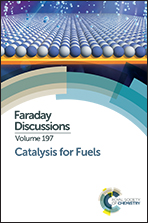Catalytic routes to fuels from C1 and oxygenate molecules
Abstract
This account illustrates concepts in chemical kinetics underpinned by the formalism of transition state theory using catalytic processes that enable the synthesis of molecules suitable as fuels from C1 and oxygenate reactants. Such feedstocks provide an essential bridge towards a carbon-free energy future, but their volatility and low energy density require the formation of new C–C bonds and the removal of oxygen. These transformations are described here through recent advances in our understanding of the mechanisms and site requirements in catalysis by surfaces, with emphasis on enabling concepts that tackle ubiquitous reactivity and selectivity challenges. The hurdles in forming the first C–C bond from C1 molecules are illustrated by the oxidative coupling of methane, in which surface O-atoms form OH radicals from O2 and H2O molecules. These gaseous OH species act as strong H-abstractors and activate C–H bonds with earlier transition states than oxide surfaces, thus rendering activation rates less sensitive to the weaker C–H bonds in larger alkane products than in CH4 reactants. Anhydrous carbonylation of dimethyl ether forms a single C–C bond on protons residing within inorganic voids that preferentially stabilize the kinetically-relevant transition state through van der Waals interactions that compensate for the weak CO nucleophile. Similar solvation effects, but by intrapore liquids instead of inorganic hosts, also become evident as alkenes condense within MCM-41 channels containing isolated Ni2+ active sites during dimerization reactions. Intrapore liquids preferentially stabilize transition states for C–C bond formation and product desorption, leading to unprecedented reactivity and site stability at sub-ambient temperatures and to 1-alkene dimer selectivities previously achieved only on organometallic systems with co-catalysts or activators. C1 homologation selectively forms C4 and C7 chains with a specific backbone (isobutane, triptane) on solid acids, because of methylative growth and hydride transfer rates that reflect the stability of their carbenium ion transition states and are unperturbed by side reactions at low temperatures. Aldol condensation of carbonyl compounds and ketonization of carboxylic acids form new C–C bonds concurrently with O-removal. These reactions involve analogous elementary steps and occur on acid–base site pairs on TiO2 and ZrO2 catalysts. Condensations are limited by α-H abstraction to form enolates via concerted interactions with predominantly unoccupied acid–base pairs. Ketonization is mediated instead by C–C bond formation between hydroxy-enolates and monodentate carboxylates on site pairs nearly saturated by carboxylates. Both reactions are rendered practical through bifunctional strategies, in which H2 and a Cu catalyst function scavenge unreactive intermediates, prevent sequential reactions and concomitant deactivation, and remove thermodynamic bottlenecks. Alkanal–alkene Prins condensations on solid acids occur concurrently with alkene dimerization and form molecules with new C–C bonds as skeletal isomers unattainable by other routes. Their respective transition states are of similar size, leading to selectivities that cannot sense the presence of a confining host. Prins condensation reactions benefit from weaker acid sites because their transition states are less charged than those for oligomerization and consequently less sensitive to conjugate anions that become less stable as acids weaken.
- This article is part of the themed collection: Catalysis for Fuels


 Please wait while we load your content...
Please wait while we load your content...